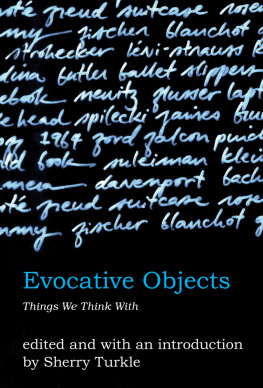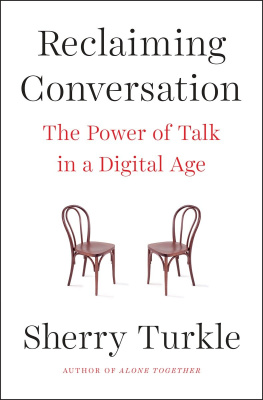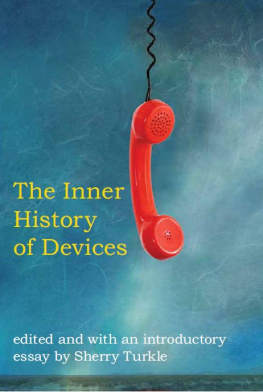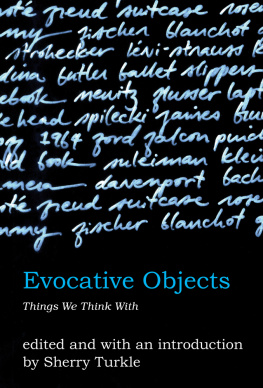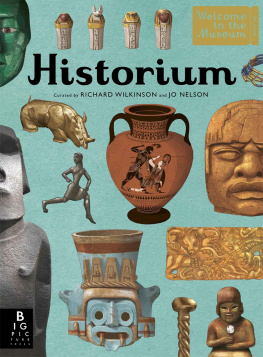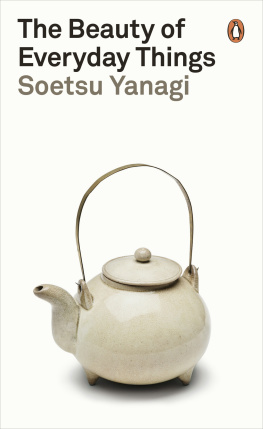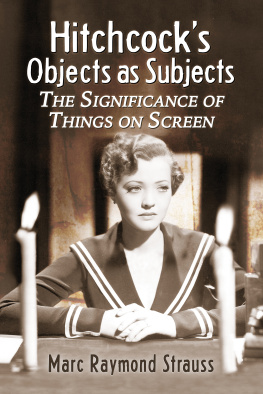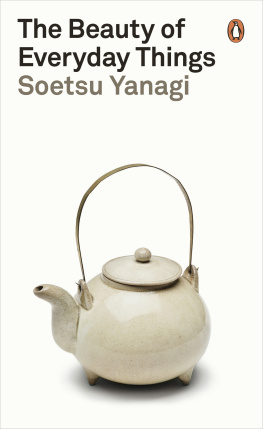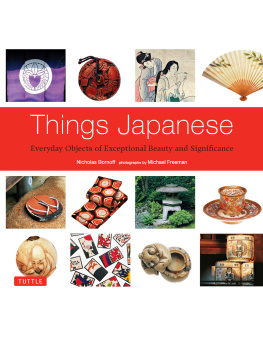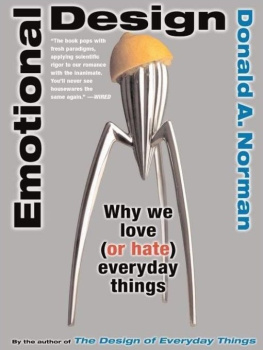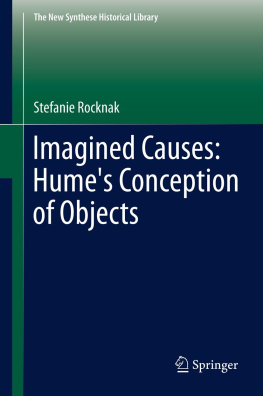Evocative Objects
Evocative Objects
Things We Think With
edited by Sherry Turkle
The MIT Press Cambridge, Massachusetts London, England
2007 Massachusetts Institute of Technology
All rights reserved. No part of this book may be reproduced in any form by any electronic or mechanical means (including photocopying, recording, or information storage and retrieval) without permission in writing from the publisher.
MIT Press books may be purchased at special quantity discounts for business or sales promotional use. For information, please Email <> or write to Special Sales Department, The MIT Press, 55 Hayward Street, Cambridge, MA 02142.
This book was set in Bookman Old Style, ITC Bookman, and Stymie by Graphic Composition, Inc., Athens, Georgia.
Printed and bound in the United States of America.
Library of Congress Cataloging-in-Publication Data
Evocative objects : things we think with / [edited by] Sherry Turkle ;
theoretical essay and bibliographical essay by Sherry Turkle.
p. cm.
Includes bibliographical references and index.
ISBN-13: 978-0-262-20168-1 (hardcover : alk. paper)
1.Transitional objects (Psychology) I. Turkle, Sherry.
BF175.5.T73E96 2007
155.9 1dc22
2006027966
10 9 8 7 6 5 4 3 2 1
To Charles Zimmerman
Contents
| Acknowledgments |
| Sherry Turkle |Introduction: The Things That Matter |
| OBJECTS OF DESIGN AND PLAY |
| Tod Machover | My Cello |
| Carol Strohecker | Knots |
| Susan Yee | The Archive |
| Mitchel Resnick | Stars |
| Howard Gardner | Keyboards |
| OBJECTS OF DISCIPLINE AND DESIRE |
| Eden Medina | Ballet Slippers |
| Joseph Cevetello | The Elite Glucometer |
| Matthew Belmonte | The Yellow Raincoat |
| Michelle Hlubinka | The Datebook |
| Annalee Newitz | My Laptop |
| Gail Wight | Blue Cheer |
| OBJECTS OF HISTORY AND EXCHANGE |
| Julian Beinart | The Radio |
| Irene Castle McLaughlin | The Bracelet |
| David Mitten | The Axe Head |
| Susan Spilecki | Dit Da Jow: Bruise Wine |
| Nathan Greenslit | The Vacuum Cleaner |
| OBJECTS OF TRANSITION AND PASSAGE |
| William J. Mitchell | The Melbourne Train |
| Judith Donath | 1964 Ford Falcon |
| Trevor Pinch | The Synthesizer |
| Tracy Gleason | Murray: The Stuffed Bunny |
| David Mann | The World Book |
| Susan Rubin Suleiman | The Silver Pin |
| OBJECTS OF MOURNING AND MEMORY |
| Henry Jenkins | Death-Defying Superheroes |
| Stefan Helmreich | The SX-70 Instant Camera |
| Glorianna Davenport | Salvaged Photographs |
| Susan Pollak | The Rolling Pin |
| Caroline A. Jones | The Painting in the Attic |
| Olivia Dast | The Suitcase |
| OBJECTS OF MEDITATION AND NEW VISION |
| Nancy Rosenblum | Chinese Scholars Rocks |
| Susannah Mandel | Apples |
| Jeffrey Mifflin | The Mummy |
| Michael M. J. Fischer | The Geoid |
| Robert P. Crease | Foucaults Pendulum |
| Evelyn Fox Keller | Slime Mold |
| Sherry Turkle | What Makes an Object Evocative? |
| Notes |
| Selected Bibliography |
| Epigraph Sources |
| Illustration Credits |
| Index |
Acknowledgments
This book began with a seminar series at the MIT Initiative on Technology and Self and became a way to capture the intellectual enthusiasms of that enterprise. I thank the Mitchell Kapor Foundation for its support of the Initiative as well as all participants in the Evocative Objects Seminar in the STS program over many years.
My research assistants Anita Chan, Olivia Dast, and Kelly Gray worked closely with me on all aspects of making this volume a reality. Deborah Cantor-Adamss labors ensured consistency and clarity. I am grateful for Erin Hasleys combination of tenacity and perfect pitch in the design work for this volume. Lisa Lius excellent transcription and editing of Initiative presentations helped many of the authors recall unscripted moments that improved the quality of their final essays.
Thanks are also due to Valerie Geary, Mark Kramer, Robert Prior, and Susan Silbey for their helpful comments on my introduction and concluding essay. Comments on the introduction by Michael Fischer, Howard Gardner, and Susan Suleiman are gratefully acknowledged. Funding from the Intel Corporation to pursue work on the complex qualities of objects and conversations with my research partner at Intel, Margaret Morris, have deepened my thinking.
This book has been a labor of love; I have lived with it for many years. I thank my daughter Rebecca for lighting up my life as I worked. Tellingly, she has resisted my recent suggestions that she tidy up her room by informing me that the stuff I want her to throw out are her evocative objects. Im taking this as a good sign that the phrase is apt to catch on with others.
Sherry Turkle
Boston, Massachusetts
January 2007
Evocative Objects
INTRODUCTION: THE THINGS THAT MATTER
Sherry Turkle
I grew up hoping that objects would connect me to the world. As a child, I spent many weekends at my grandparents apartment in Brooklyn. Space there was limited, and all of the family keepsakesincluding my aunts and my mothers books, trinkets, souvenirs, and photographswere stored in a kitchen closet, set high, just below the ceiling. I could reach this cache only by standing on the kitchen table that I moved in front of the closet. This I had been given permission to do, and this is what I did, from age six to age thirteen or fourteen, over and over, weekend after weekend. I would climb onto the table in the kitchen and take down every book, every box. The rules were that I was allowed to look at anything in the closet, but I was always to put it back. The closet seemed to me of infinite dimensions, infinite depth.
Each object I found in the closetevery keychain, postcard, unpaired earring, high school textbook with its marginalia, some of it my mothers, some of it my auntssignaled a new understanding of who they were and what they might be interested in; every photograph of my mother on a date or at a dance became a clue to my possible identity. My biological father had been an absent figure since I was two. My mother had left him. We never spoke about him. It was taboo to raise the subject. I did not feel permitted to even think about the subject.
My aunt shared the small apartment with my grandmother and grandfather, and sometimes one of them would come into the kitchen to watch me at my investigations. At the time I didnt know what I was looking for. I think they did. I was looking, without awareness, for the one who was missing. I was looking for a trace of my father. But they had been there before me and gotten rid of any bits and pieces he might have leftan address book, a business card, a random note. Once I found a photograph of a man standing on a boardwalk with his face cut out of the picture. I never asked whose face it was; I knew. And I knew enough never to mention the photograph, for fear that it too would disappear. It was precious to me. The image had been attacked, but it contained so many missing puzzle pieces. What his hands looked like. That he wore lace-up shoes. That his pants were tweed.
Next page
